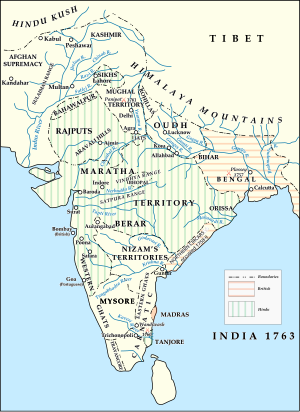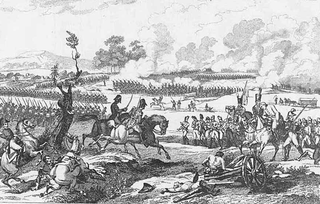
The Battle of Pozzolo also known as the Battle of the Mincio River and Monzambano was fought during the War of the Second Coalition. A French army under General Guillaume Brune crossed the Mincio River and defeated an Austrian force under General Heinrich von Bellegarde. The Austrians were subsequently pushed back to Treviso where the Armistice of Treviso was signed. This truce would lead to the Treaty of Lunéville and the withdrawal of Austria from the war.

Lieutenant-General Sir Eyre Coote, KB was an Anglo-Irish military officer and politician who sat in the House of Commons from 1768 to 1780. He is best known for his many years of service with the British Army in India. His victory at the Battle of Wandiwash is considered a decisive turning point in the struggle for control in India between Britain and France. He was known by his sepoy troops as Coote Bahadur.

The Battle of Plassey was a decisive victory of the British East India Company, under the leadership of Robert Clive, over the Nawab of Bengal and his French allies on 23 June 1757. The victory was made possible by the defection of Mir Jafar, Nawab Siraj-ud-Daulah's commander in chief. The battle helped the British East India Company take control of Bengal in 1772. Over the next hundred years, they continued to expand their control over vast territories in the rest of the Indian subcontinent, including Burma.
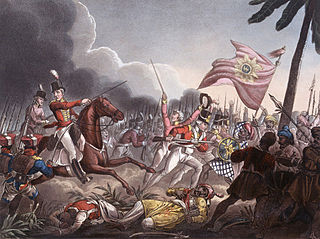
The Battle of Assaye was a major battle of the Second Anglo-Maratha War fought between the Maratha Empire and the British East India Company. It occurred on 23 September 1803 near Assaye in western India. An outnumbered Indian and British force, under the command of Major General Arthur Wellesley, defeated the combined Maratha army of Daulatrao Scindia and the Bhonsle Raja of Berar. The battle was Wellesley's first major victory and the one he later described as his finest accomplishment on the battlefield, even more so than his more famous victories in the Peninsular War, and his defeat of Napoleon Bonaparte at the Battle of Waterloo.

Sepoy, related to sipahi, is a term denoting professional Indian infantryman, traditionally armed with a musket, in the armies of the Mughal Empire and the Maratha Army.
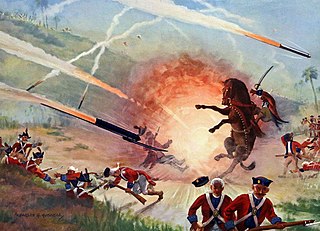
The Battle of Pollilur, also known as the Battle of Polilore or Battle of Perambakam, took place on 10 September 1780 at Pollilur near Conjeevaram, the city of Kanchipuram in present-day Tamil Nadu state, India, as part of the Second Anglo-Mysore War. It was fought between an army commanded by Tipu Sultan of the Kingdom of Mysore, and a British East India Company force led by William Baillie. The EIC force suffered a high number of casualties before surrendering. It was the worst loss the East India Company suffered on the subcontinent until Chillianwala. Benoît de Boigne, a French officer in the service of 6th Regiment of Madras Native Infantry, wrote, "There is not in India an example of a similar defeat".

Vandavasi is a major town and a municipality in the Tiruvannamalai district of the Indian state of Tamil Nadu. The town is well known in the Carnatic history for the Battle of Wandiwash. Vandavasi town is also the largest manufacturer of kora artefacts including mats, shawls and vessels. As of 2011, the town had a population 74,320.

Chennai, formerly known as Madras, is the capital of the state of Tamil Nadu and is India's fifth largest city. It is located on the Coromandel Coast of the Bay of Bengal. With an estimated population of 8.9 million (2014), the 383-year-old city is the 31st largest metropolitan area in the world.
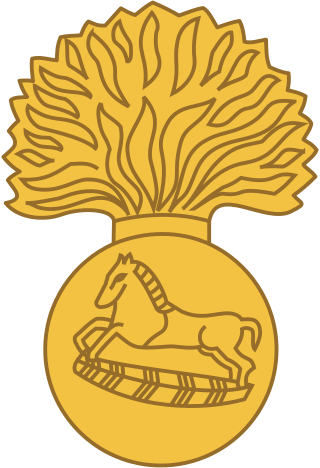
The Grenadiers is an infantry regiment of the Indian Army, formerly part of the Bombay Army and later the pre-independence British Indian Army, when the regiment was known as the 4th Bombay Grenadiers. It has distinguished itself during the two world wars and also since the Independence of India. The regiment has won many battle honours and gallantry awards, and is considered to be one of India's most decorated regiments with three Param Vir Chakra awardees in three different conflicts.

The siege of Seringapatam was the final confrontation of the Fourth Anglo-Mysore War between the British East India Company and the Kingdom of Mysore. The British, with the allied Nizam Ali Khan, 2nd Nizam of Hyderabad and Marathas, achieved a decisive victory after breaching the walls of the fortress at Seringapatam and storming the citadel. The leader of the British troops was Major General David Baird, among the lesser known allies were the Portuguese in Goa and Damaon. Tipu Sultan, the de facto ruler after the death of his father, who had usurped the throne of Mysore, was killed in the action. The British restored the Wodeyar dynasty back to power after the victory through a treaty of subsidiary alliance and Krishnaraja Wodeyar III was crowned the King of Mysore. However, they retained indirect control of the kingdom's external affairs.

The Battle of Buxar was fought between 22 and 23 October 1764, between the forces of the British East India Company, under the command of Major Hector Munro, and the combined armies of Balwant Singh, Maharaja of the Banaras State; Mir Qasim, Nawab of Bengal; Shuja-ud-Daula, Nawab of Awadh; and Shah Alam II, Emperor of the Mughal Empire. The battle was fought at Buxar, a "strong fortified town" within the territory of Bihar, located on the banks of the Ganges river about 130 kilometres (81 mi) west of Patna; it was a challenging victory for the British East India Company. The war was brought to an end by the Treaty of Allahabad in 1765. The defeated Indian rulers were forced to sign this treaty, granting the East India Company diwani rights, which allowed them to collect revenue from the territories of Bengal, Bihar, and Orissa on behalf of the Mughal emperor. This gave the company immense economic control, enabling them to pass financial policies to exploit the resources of the region for their own benefit.

The Madras Regiment is the oldest infantry regiment of the Indian Army, originating in the 1750s as a unit of the British East India Company. The regiment took part in numerous campaigns with the British Indian Army and the post-independence Indian Army.

The Battle of Saragossa, also known as the Battle of Zaragoza, took place on 20 August 1710 during the War of the Spanish Succession. A Spanish Bourbon army loyal to Philip V of Spain and commanded by the Marquis de Bay was defeated by a Grand Alliance force under Guido Starhemberg. Despite this victory, which allowed Philip's rival Archduke Charles to enter the Spanish capital of Madrid, the allies were unable to consolidate their gains. Forced to retreat, they suffered successive defeats at Brihuega in November and Villaviciosa in December, which effectively ended their chances of installing Archduke Charles on the Spanish throne.

Vellore Fort is a large 16th-century fort situated in heart of the Vellore city, in the state of Tamil Nadu, India built by the Emperors of Vijayanagara. The fort was at one time the imperial capital of the Aravidu Dynasty of the Vijayanagara Empire. The fort is known for its grand ramparts, wide moat and robust masonry.
The Battle of Badli-ki-Serai was fought early in the Indian Rebellion of 1857, or First War of Indian Independence as it has since been termed in Indian histories of the events. A British and Gurkha force defeated a force of sepoys who had rebelled against the British East India Company. The British victory allowed them to besiege and ultimately capture Delhi.

The presidency armies were the armies of the three presidencies of the East India Company's rule in India, later the forces of the British Crown in India, composed primarily of Indian sepoys. The presidency armies were named after the presidencies: the Bengal Army, the Madras Army and the Bombay Army. Initially, only Europeans served as commissioned or non-commissioned officers. In time, Indian Army units were garrisoned from Peshawar in the north, to Sind in the west, and to Rangoon in the east. The army was engaged in the wars to extend British control in India and beyond.

The Bombay Army was the army of the Bombay Presidency, one of the three presidencies of British India.

The siege of Bergen op Zoom took place during the Austrian War of Succession, when a French army, under the command of Count Löwendal and the overall direction of Marshal Maurice de Saxe, laid siege and captured the strategic Dutch border fortress of Bergen op Zoom on the border of Brabant and Zeeland in 1747. The fortress was defended by Dutch, Austrians, British, Hanoverians and Hessians that supported the Pragmatic Sanction.

The siege of Madras was a siege of Madras, which was then under British rule, between December 1758 and February 1759 by French forces under the command of Comte de Lally during the Seven Years' War. The British garrison was able to hold out until it was relieved.
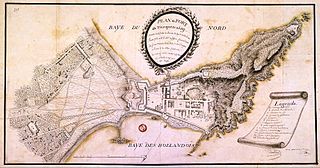
The Capture of Trincomalee on 11 January 1782 was the second major engagement between Great Britain and the Dutch East India Company in the East Indies after the outbreak of the Fourth Anglo-Dutch War. After capturing Negapatam, the major Dutch outpost in India, a British force assaulted the Dutch-controlled port of Trincomalee on the eastern coast of Ceylon, and successfully stormed Fort Fredrick and Fort Ostenburg to gain control of the city and the port. In gaining control of the port, they also captured the vessels there at the time.




